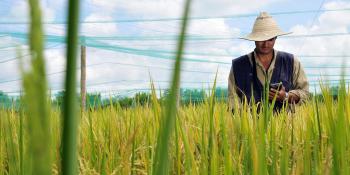Big Facts: Focus on Sub-Saharan Africa
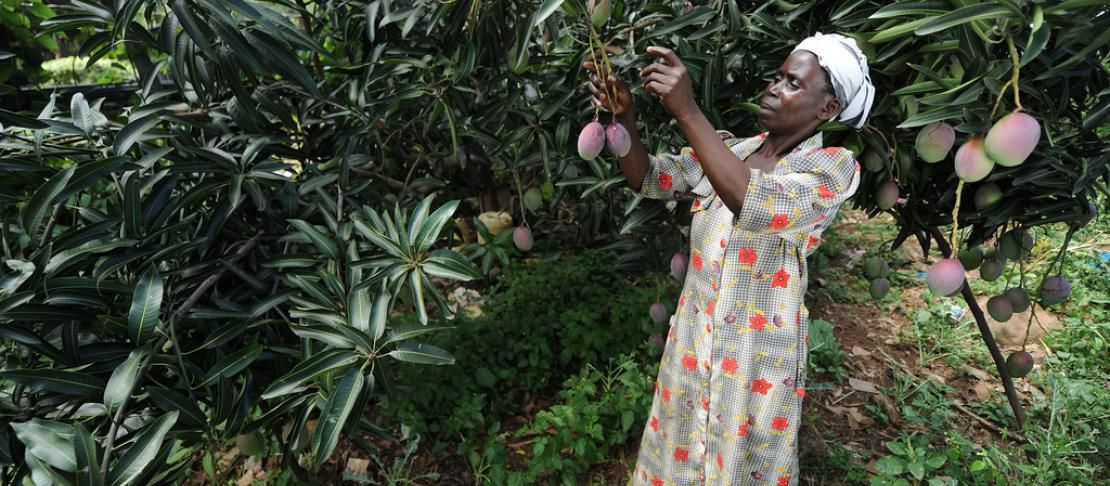
This story spotlights some of the Big Facts on Sub-Saharan Africa, and is part of a special blog series to complement the new Big Facts infographics website.
All regions are challenged by climate change but some are facing tougher challenges than others. In Sub-Saharan Africa, severe climatic changes, low adaptive capacity and high levels of food insecurity make for a tough task. But large unused tracts of land, potential to significantly increase yields, as well as a young and growing population, offer glimmers of hope.
Population growth about to step up a gear
In some countries, population growth is slowing, others are in the midst of growing, and then there are those just getting started. The countries of Sub-Saharan Africa belong to the latter group. Currently a bit below a billion, the population of Sub-Saharan Africa is projected to reach more than 2 billion or 22% of the world total by 2050. By 2080, Sub-Saharan Africa will be the only region in the world with a population that is still growing. All other regions are projected to experience a slowdown in population growth and eventually a shift towards negative growth, as is already seen in some European countries (UN-DESA, 2013).
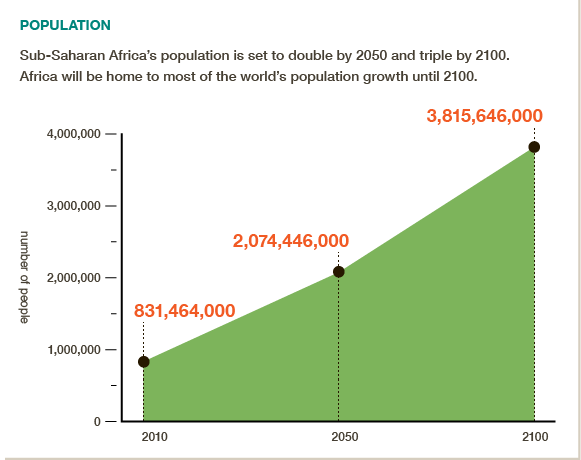
Undernutrition set to get under control
In many countries in Sub-Saharan Africa, food insecurity is a serious problem. This region has the highest prevalence of undernutrition according to the latest projection by the United Nations Food and Agriculture Organization. However, while 21.4% of the population is projected to be undernourished in 2015, this is expected to decrease to 14.5% by 2030 and 7.1 % by 2050 (Alexandratos and Bruinsma, 2012: 27).
While this is good news, increasing the diversity of diets in Africa still remains a key issue; roots, tubers and plantains have traditionally been the mainstay of food consumption in several of the Sub-Saharan African countries. Ten countries depend on these products for over 30% of food consumption in terms of calories (Alexandratos and Bruinsma, 2012: 48).
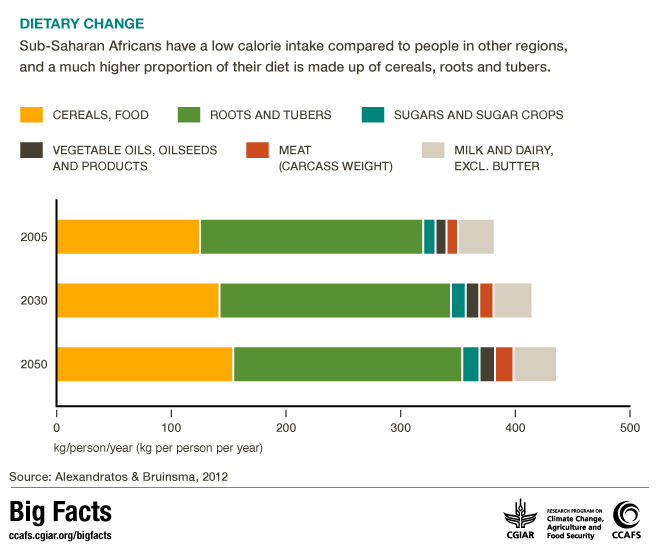
A continent of contrasts when it comes to crop yields
In a study of changes to yield under climate change, Ray and colleagues found that, “Africa is a continent of contrasts”. For example, maize yields will have doubled by 2050 in some isolated areas of Ethiopia, Angola, South Africa, and Madagascar, but they are decreasing in Chad, Somalia, Kenya, Zambia, Zimbabwe, Rwanda, Burundi, and the Democratic Republic of Congo.
Another problem is that even in those areas where yields are growing, in some places they are not growing as fast as the population, meaning that production per capita is likely to decline (Ray et al. 2013: 5).
Emissions: from farms and forests
The greenhouse gas (GHG) emissions from the food supply chain in Sub-Saharan Africa are heavily dominated by emissions taking place on the farm and in the first steps of the supply chain; this is exacerbated by inadequate infrastructure and market access in many areas, leading to high levels of waste on farm and during post-harvest handling. Overall, however, the amount of food that each person wastes is low compared to most regions.
Looking ahead, a significant part of the GHG emissions generated will likely come from changing land use, specifically deforestation. There are still large unused tracts of land with varying degrees of agricultural potential in several countries. Alexandratos and Bruisma (2012: 113) estimate that about 50% of the land that is expected to be brought under cultivation by 2050 will be in Sub-Saharan Africa. While this could generate large emissions, it also has potential to increase food production significantly, hopefully improving food security in the region.
Impacts on People
To many people in Sub-Saharan Africa, climate change is already a reality. The people who are being hit hardest are those who depend on natural resources for their livelihoods. And those living on the land in Africa are especially vulnerable. 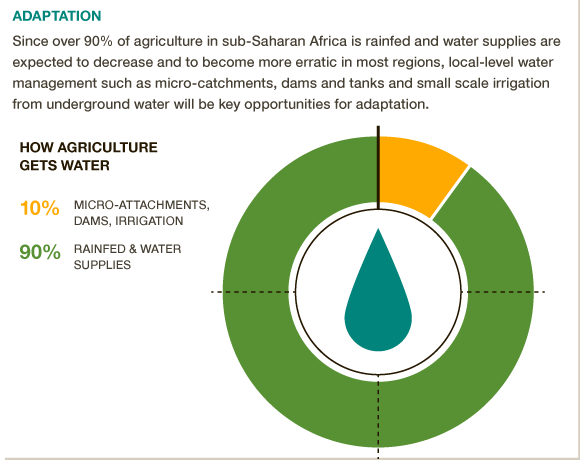 On one front, significant portions of the land rely on rain-fed agriculture, a system which will come under pressure as the temperature and precipitation levels change (Tirado and Meerman, 2010: 49). At the same time, a host of non-climate factors such as unequal land distribution, insecure land tenure, poorly developed markets, trade barriers, and inadequate infrastructure also contribute to vulnerability (UNEP, 2011).
On one front, significant portions of the land rely on rain-fed agriculture, a system which will come under pressure as the temperature and precipitation levels change (Tirado and Meerman, 2010: 49). At the same time, a host of non-climate factors such as unequal land distribution, insecure land tenure, poorly developed markets, trade barriers, and inadequate infrastructure also contribute to vulnerability (UNEP, 2011).
On the positive side, climate change is bringing communities together with researchers and other partners and adaptation and mitigation actions are starting to occur on the ground. These efforts have been successfully targeting women farmers who are the most affected and already a few champion farmers are rising above the challenges faced by climate change and are showing others the way.
Impacts on crops
As a sector heavily dependent on the climate, agriculture will be exposed to the impacts of climate extremes in Africa. As climate change progresses, it is increasingly likely that current cropping systems will no longer be viable in many locations.
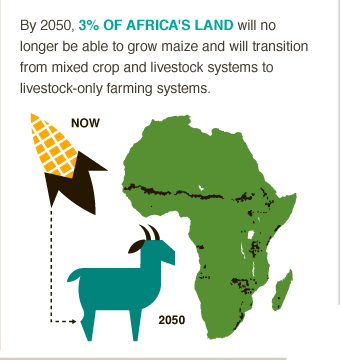
Jones and Thornton (2008) found that under a range of scenarios to 2050, 35 million farmers across 3% of the continent’s land area will need to switch from mixed crop-livestock systems to livestock only.
There are many conflicting and contradictory predictions of how crop yields will change as a result of climate change, with many predicting declines in key crops, making adaptation all the more important
Adaptation
As more than 90% of agriculture in Sub-Saharan Africa is rainfed, increasing water-storage capacity, such as small tanks, ponds and reservoirs can help farmers adapt to variability in water supply and increase production (IWMI, 2010). To deal with erratic rainfall, accessible and reliable seasonal weather forecasts will also be needed, crop diversification and insurance systems must be introduced, and in places where flooding is a risk, crops tolerant to submergence should be planted.
Adaptive measures to deal with higher temperatures include crop diversification and the introduction of stress-tolerant varieties, implementing water-conserving agriculture, and exploring options for agroforestry (Oxfam, 2011).
Many local populations in Africa, especially those in the Sahel region, have experienced climate change in the past, and have “developed and realized extensive adaptation strategies that have enabled them to reduce their vulnerability”. This acquired indigenous knowledge should be utilized to help them and others deal with the impacts of future climate change (Nyong et al., 2007).
Mitigation
Deforestation is an issue in some parts of Sub-Saharan Africa and a significant contributor of GHG emissions. By reducing deforestation and forest degradation, emissions could be reduced significantly.
Agroforestry could also contribute to the mitigation of climate change through carbon sequestration. As many as 630 million hectares of unproductive cropland and grassland could be converted to agroforestry systems, significantly reducing emissions (Verchot et al. 2004).
Finally, rangelands form the majority of agricultural land in Sub-Saharan Africa, especially in the arid and semi-arid regions. By implementing cropland and grazing land management (e.g. controlling overgrazing and pasture improvement) significant amounts of carbon can be sequestered (Smith et al., 2007).
DIG DEEPER
This short post is by no means an exhaustive overview of the various issues related to climate change and agriculture in Sub-Saharan Africa. I invite you to dig deeper into the various facts and graphics on the site and explore the differences and similarities between the different regions. In each of the sections, numerous references are given, should you want to explore a topic further.
HAVE YOUR SAY
How can Sub-Saharan Africa meet the challenges presented by climate change? Leave your ideas in the comments section below or send us an email.
Now you can get all the Big Facts on the links between climate change, agriculture and food security at ccafs.cgiar.org/bigfacts2014. The new site features over 100 stunning infographics that illustrate the most up-to-date, thoroughly researched information on these topics.
Big Facts is also an open-access resource. You can download and share the graphics with your friends and colleagues and use them in your presentations and reports. Please do not hesitate to send us any suggestions for improvements, either by commenting below or sending us an email.
This story is part of a series focusing on the Big Facts on various topics and in different regions; join the conversation at ccafs.cgiar.org/blog and on twitter using #bigfacts


